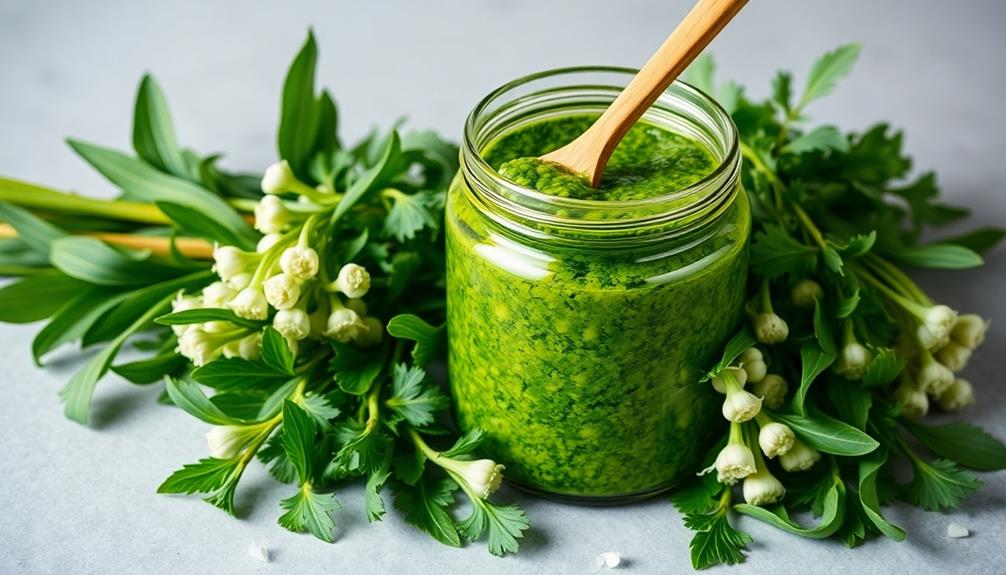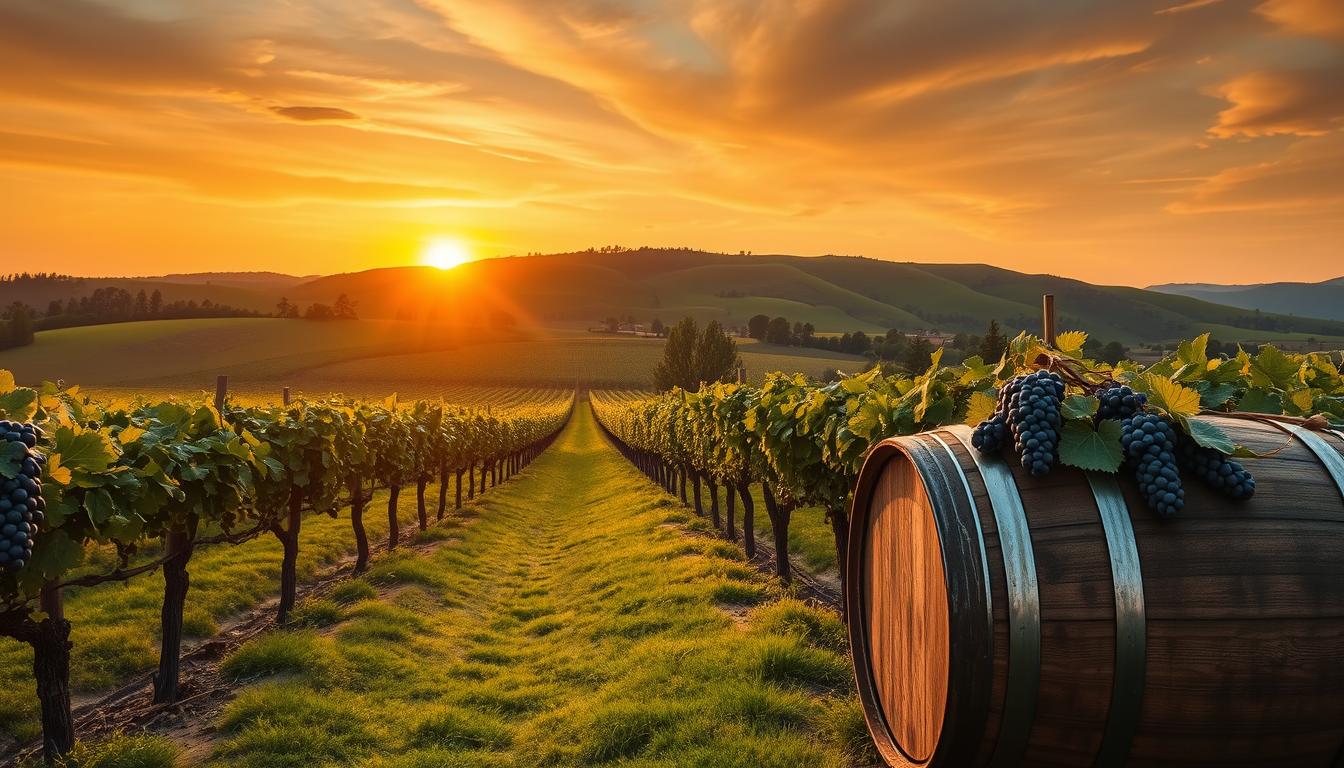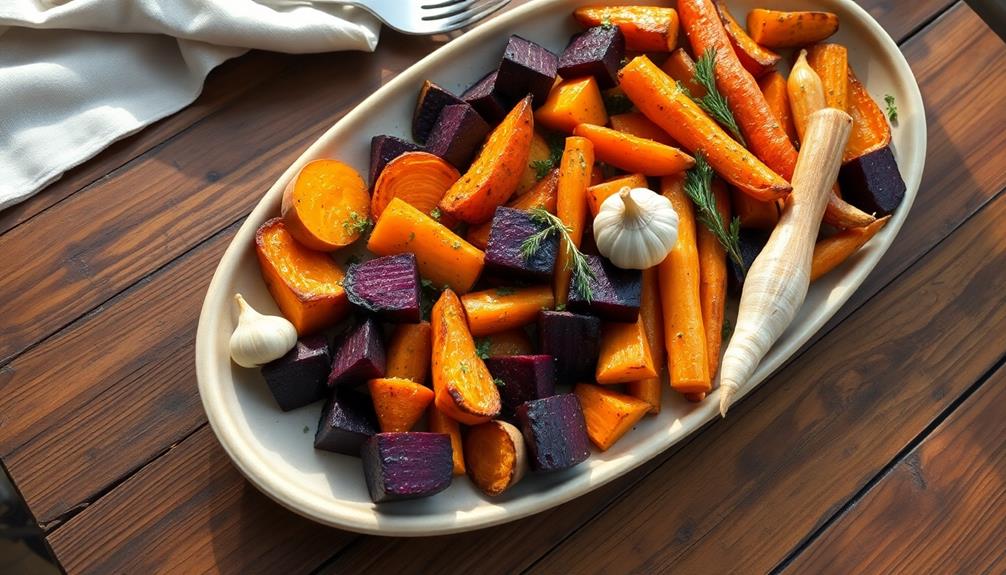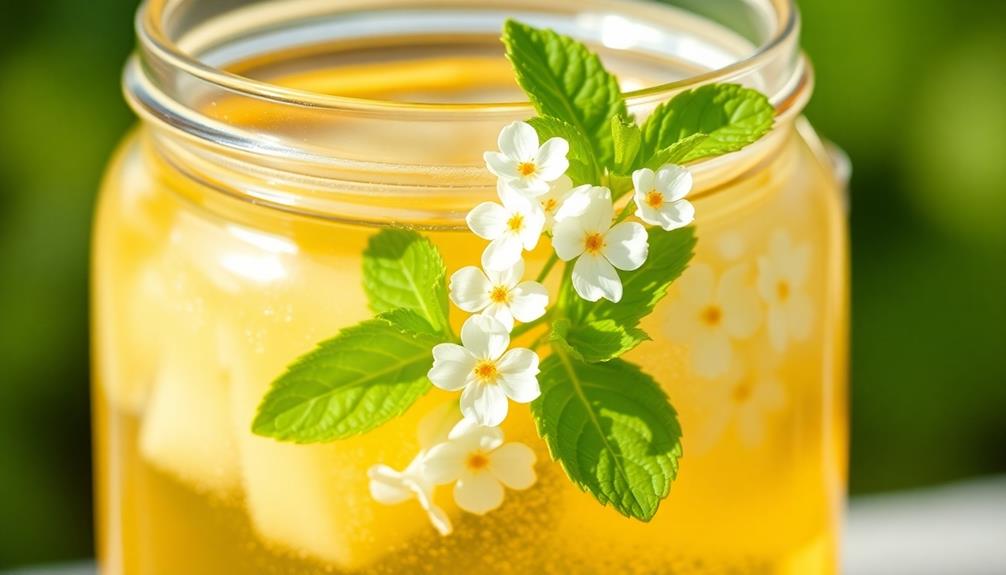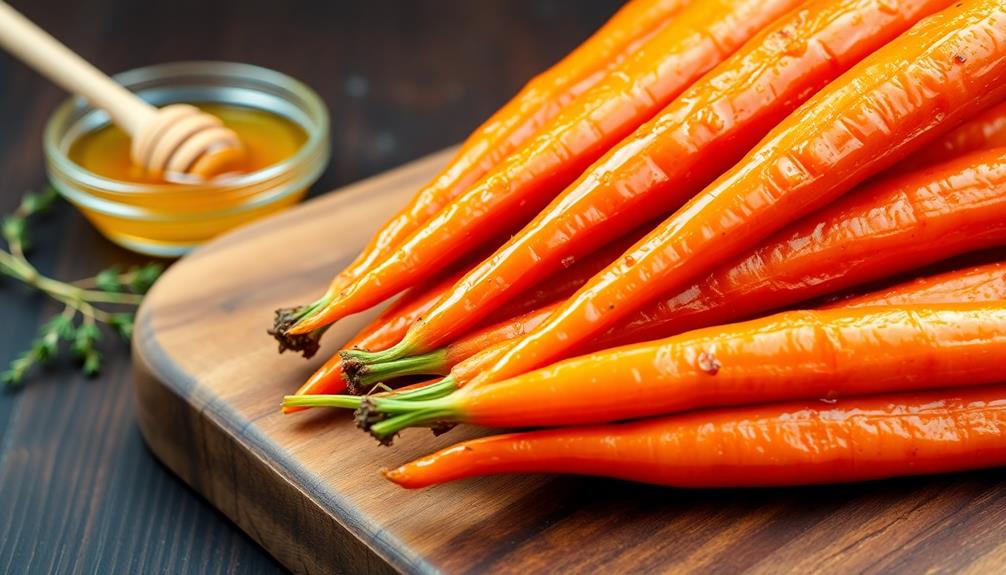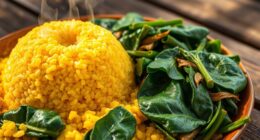Foraged wild garlic pesto is a delightful springtime condiment that captures the bold, garlicky essence of this wild plant. You'll love its vibrant, mild flavor – far more delicate than cultivated garlic. Sustainably harvested from woodlands, wild garlic leaves, flowers, and stems come together with toasted pine nuts, Parmesan, and olive oil for a versatile pesto you can enjoy on pasta, drizzle over grilled meats, or use as a spread. Beyond its culinary appeal, this pesto offers impressive nutritional benefits too. Get ready to discover more about this flavorful, seasonal delight. As a bonus, wild garlic pesto also pairs beautifully with a variety of dishes, such as roasted vegetables or as a dip for crusty bread. Its savory, earthy notes complement a wide range of flavors, making it a versatile addition to your culinary repertoire. For a truly unforgettable springtime meal, try using wild garlic pesto in a foraged mushroom risotto recipe for a dish that truly celebrates the season’s bountiful flavors.
Key Takeaways
- Wild garlic, also known as ramsons or bear's garlic, is a foraged ingredient with a distinctive garlicky flavor prevalent in European cuisine.
- Sustainable harvesting of wild garlic in spring ensures optimal flavor while preserving the ecosystem.
- Foraged wild garlic pesto combines the leaves and flowers with nuts, cheese, and olive oil for a vibrant, versatile condiment.
- Wild garlic pesto offers nutritional benefits, including vitamins, antioxidants, and antimicrobial properties from the garlic compounds.
- This seasonal pesto celebrates the tradition of foraging and promotes awareness of local, sustainable food sources.
History
Wild garlic, also known as ramsons or bear's garlic, has long been a part of traditional foraging practices throughout Europe. For centuries, people have sought out the plant's distinctive, garlicky flavor, using it in various dishes and remedies. In many regions, wild garlic has been a springtime staple, signaling the arrival of the growing season.
Historically, wild garlic was particularly valued for its medicinal properties. Ancient civilizations like the Greeks and Romans recognized its potential to treat a range of ailments, from respiratory issues to digestive problems.
During the Middle Ages, wild garlic was often used to ward off illness and plague, thanks to its antimicrobial and antiseptic qualities.
Today, the practice of foraging for wild garlic continues, with enthusiasts relishing the opportunity to connect with nature and rediscover the flavors of the past. As interest in sustainable, locally-sourced ingredients grows, this versatile wild plant has experienced a resurgence in popularity, making it a treasured ingredient in modern culinary creations.
Recipe
Wild garlic, also known as ramsons, is a delightful spring-time ingredient that can be foraged and used to create a vibrant and flavorful pesto. This recipe showcases the unique taste of wild garlic, which has a milder and sweeter flavor compared to its cultivated cousin, regular garlic.
Foraging for wild garlic is a rewarding experience, as it allows you to connect with the natural world and incorporate fresh, locally-sourced ingredients into your cooking. When preparing this pesto, be mindful of using the entire wild garlic plant, including the leaves and flowers, to capture the full depth of flavor.
- 2 cups (packed) wild garlic leaves and flowers
- 1/2 cup pine nuts or walnuts
- 1/2 cup grated Parmesan cheese
- 1/2 cup extra-virgin olive oil
- Juice of 1 lemon
- Salt and freshly ground black pepper to taste
In a food processor, combine the wild garlic leaves and flowers, nuts, Parmesan cheese, olive oil, and lemon juice. Pulse until a coarse pesto-like consistency is achieved, being careful not to overmix. Season with salt and pepper to taste.
This wild garlic pesto can be used in a variety of ways, such as tossed with pasta, spread on toast or crostini, or used as a dip for fresh vegetables.
The pesto can be stored in an airtight container in the refrigerator for up to 1 week, or frozen for longer-term storage. When ready to use, allow the pesto to come to room temperature before serving.
Cooking Steps
First, rinse and trim the wild garlic leaves.
Next, toast the pine nuts in a dry pan until fragrant.
Then, blend the garlic, nuts, olive oil, and seasoning in a food processor, before stirring in the Parmesan cheese and transferring the pesto to a jar.
Step 1. Rinse and Trim Wild Garlic
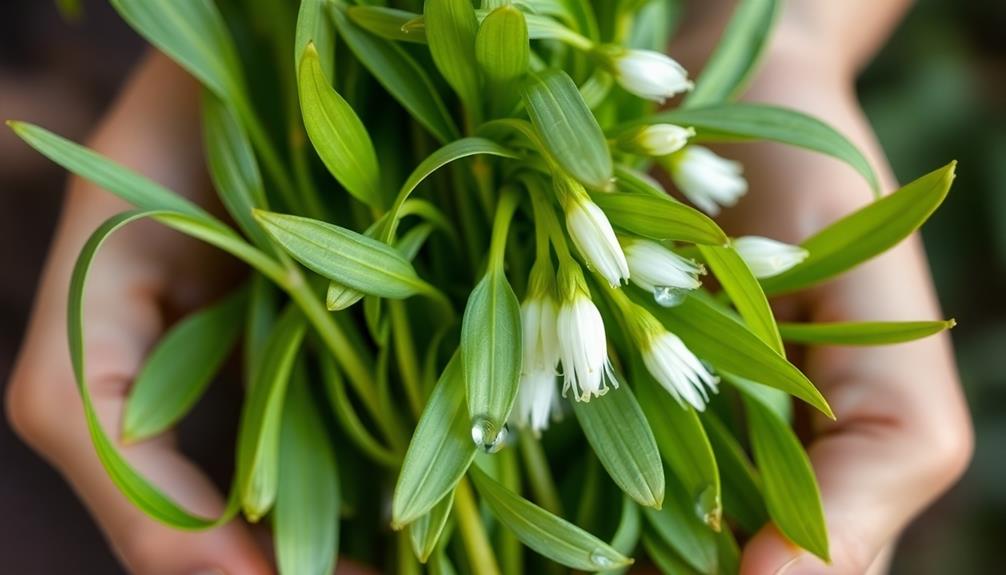
Begin by gently rinsing the foraged wild garlic under cool running water. This will remove any dirt or debris that may have clung to the leaves during the foraging process.
Carefully examine each leaf, looking for any damaged or discolored areas, and trim them away using a sharp knife or kitchen shears. You don't want to include any imperfect leaves in your pesto, as they can impart a bitter or off-flavor.
Once the leaves are clean and trimmed, pat them dry with a clean kitchen towel or paper towels. This step is crucial, as you don't want any excess moisture in the pesto, which could dilute the flavor and texture.
With your wild garlic prepped and ready, you can now move on to the next step of the pesto-making process, which involves combining the leaves with the other key ingredients.
Step 2. Toast Pine Nuts
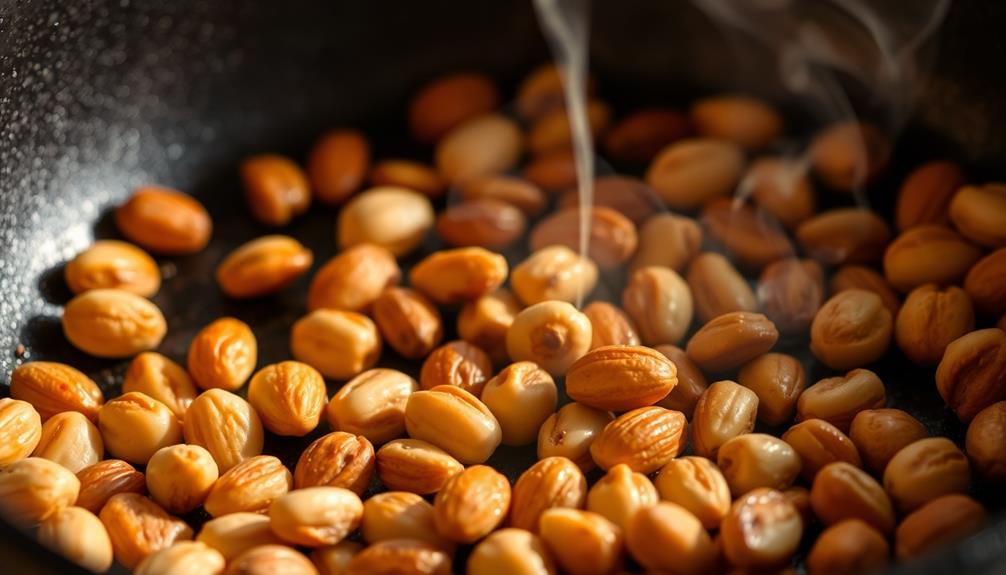
With your wild garlic prepped and ready, let's move on to toasting the pine nuts.
Grab a small skillet and place it over medium heat. Once the pan is hot, add the pine nuts in a single layer. Keep a close eye on them, stirring frequently, as pine nuts can burn quickly.
You'll know they're ready when they're lightly golden and fragrant, which should take about 2-3 minutes. Be careful not to let them get too dark, as that can make them taste bitter.
Once they're perfectly toasted, transfer the pine nuts to a plate or bowl to stop the cooking. This step adds a lovely, nutty flavor to the pesto.
Next, we'll add the toasted pine nuts to the food processor along with the other pesto ingredients. The pine nuts will help create a creamy, textured pesto that's bursting with the fresh, garlicky flavor of the wild greens you foraged.
Step 3. Blend Ingredients in Food Processor
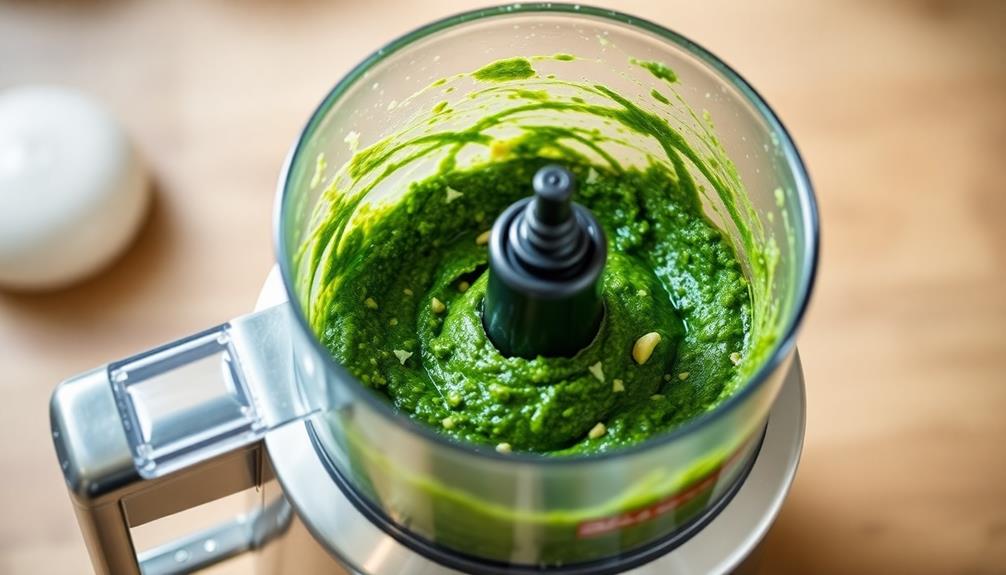
With the toasted pine nuts ready, add them to your food processor along with the wild garlic leaves, Parmesan cheese, olive oil, and a pinch of salt and pepper.
Pulse the ingredients a few times to begin the blending process. Scrape down the sides of the food processor as needed to ensure even mixing.
Continue blending until the mixture forms a smooth, creamy pesto. You may need to add a bit more olive oil if the pesto seems too thick.
Taste the pesto and adjust the seasoning with additional salt and pepper if desired. The final texture should be spreadable yet retain some coarse texture from the pine nuts.
Blend for a minute or two more if you'd like the pesto to be silkier in consistency.
Once you're satisfied with the flavor and texture, transfer the wild garlic pesto to an airtight container until ready to use.
Step 4. Add Parmesan Cheese

Next, add the grated Parmesan cheese to the food processor. The amount of cheese you use will depend on your personal taste preferences, but we recommend starting with 1/2 cup of freshly grated Parmesan.
Pulsing the food processor, incorporate the cheese until it's fully blended into the mixture. The Parmesan will add a salty, savory flavor that balances the pungency of the wild garlic.
Feel free to add more cheese if you prefer a richer, more pronounced cheese flavor. Just be sure not to overdo it, as you don't want the Parmesan to overpower the delicate notes of the wild garlic.
Once the cheese is fully incorporated, give the pesto a taste and adjust the seasoning as needed, adding more salt or pepper to suit your palate.
With the Parmesan cheese blended in, your wild garlic pesto is now ready to use in your favorite pasta dishes, spread on bread, or tossed with roasted vegetables.
Step 5. Transfer to Jar

Once the wild garlic pesto is blended to your desired consistency, transfer it to a clean, airtight jar. This will help preserve the vibrant color and fresh flavor of the pesto.
Gently spoon or pour the pesto into the jar, filling it almost to the top. Be sure to leave a small amount of headspace to allow for expansion. Secure the lid tightly, ensuring there are no gaps that could allow air to enter.
For optimal freshness, store the jar in the refrigerator. The pesto will keep for up to a week this way.
When you're ready to use it, simply scoop out what you need and enjoy it on pasta, bread, or as a flavorful dip. The pesto's bright, garlicky notes will elevate any dish.
Final Thoughts
Ultimately, the vibrant and versatile wild garlic pesto you've crafted showcases the abundance of nature's bounty.
You've harnessed the bold, garlicky flavor of foraged wild garlic, blended it with the richness of pine nuts and the fruity notes of olive oil, creating a versatile condiment that can elevate a variety of dishes.
Whether you dollop it onto roasted vegetables, toss it with pasta, or use it as a spread for crusty bread, this pesto is a testament to the power of seasonal, locally-sourced ingredients.
It's a simple yet satisfying way to bring the flavors of the great outdoors into your kitchen.
As you savor each bite, you'll be reminded of the joy of foraging and the deep connection to the natural world that comes from preparing your own wild foods.
Enjoy this pesto as a celebration of the bountiful season and the nourishment that can be found in the wilds around us.
Frequently Asked Questions
Where Can I Find Wild Garlic in My Area?
You can find wild garlic in damp, shaded areas like woodland edges and riverbanks. Look for the distinctive broad leaves and pungent garlic aroma, and be sure to properly identify it before foraging.
How Do I Identify Wild Garlic From Other Plants?
To identify wild garlic, look for its broad, flat leaves and distinctive garlic smell. The leaves grow in clusters near the base of the plant, and the flowers are small and white.
Can I Use Wild Garlic Instead of Regular Garlic?
You can absolutely use wild garlic instead of regular garlic. The flavors are similar, and wild garlic can make a great substitute in many recipes. Just be sure to identify it correctly to avoid any potential hazards.
How Long Does Homemade Wild Garlic Pesto Last?
Homemade wild garlic pesto can last 5-7 days in the fridge when stored in an airtight container. The fresher the ingredients, the longer it'll stay fresh. Just be sure to give it a sniff before using it.
Is Wild Garlic Pesto Suitable for Vegetarian or Vegan Diets?
Yes, wild garlic pesto is suitable for vegetarian or vegan diets. It's typically made with just a few simple ingredients like wild garlic, nuts, oil, and seasoning, without any animal products.
